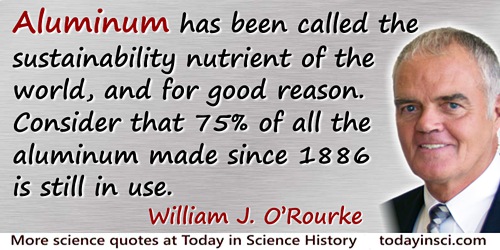Nutrient Quotes (8 quotes)
A plant is a living thing that absorbs in microscopic amounts over its surface what it needs for growth. It spreads therefore an exterior whereas the animal develops, through its mouth, an interior. The definition is vague but it gives the reason why the limb of a tree ends in leaves, not fingers, and it helps to explain how in the long run of evolution a monkey came to sit on the tree and a cow to ruminate in its shade.
Opening of Chapter 1, The Life of Plants (1964, 2002), 1.
According to the historian D. B. McIntyre (1963), James Hutton, often known as the father of geology, said in a lecture before the Royal Society of Edinburgh in the 1790s that he thought of the Earth as a superorganism and that its proper study would be by physiology. Hutton went on to make the analogy between the circulation of the blood, discovered by Harvey, and the circulation of the nutrient elements of the Earth and of the way that sunlight distills water from the oceans so that it may later fall as rain and so refresh the earth.
In 'The Earth as a Living Organism', Essay collected in E. O. Wilson and F. M. Peter (eds.), Biodiversity (1988), Chap. 56, 488. [Notes: Donald Bertram McIntyre (1923–2009) was a geologist. Hutton had medical training early in his life. According to Mirriam-Webster’s dictionary, the first known use of the word “superorganism” was “circa 1899”—so Hutton did not use that word. However, McIntyre did adopt that sophisticated word to describe Hutton’s thought, twice, in Philosophy of Geology (1963), 7 & 10. Thus, McIntyre and Lovelock freely embroidered whatever Hutton actually wrote, perhaps over-stepping. Cándido Manuel García Cruz criticizes that these “assertions are merely a misinterpretation” although “Hutton has nevertheless an holistic view which is closer to the Alfred N. Whitehead’s organic mechanicism than the James Lovelock’s Gaia Hypothesis,” as quoted from the abstract of his article 'From James Hutton’s «Theory of the Earth» to James Lovelock’s «Gaia Hypothesis»', Asclepio; Archivo Iberoamericano de Historia de la Medicina y Antropología Médica (Jun 2007), 59, No. 1, 65-100. Thus, it is best to read his own words in James Hutton, Theory of the Earth, which at length describes the “terrestrial system” as a “machine of a peculiar construction.” —Webmaster]
Aluminum has been called the sustainability nutrient of the world, and for good reason. Consider that 75% of all the aluminum made since 1886 is still in use. So from a sustainability standpoint alone, yes, [Charles] Hall really did become that benefactor to humanity—big time.
As quoted in 'Alcoa Co-Founder Charles Hall Smelt Success' (20 Jul 2012), article on investors.com website.
I propose to provide proof... that just as always an alcoholic ferment, the yeast of beer, is found where sugar is converted into alcohol and carbonic acid, so always a special ferment, a lactic yeast, is found where sugar is transformed into lactic acid. And, furthermore, when any plastic nitrogenated substance is able to transform sugar into that acid, the reason is that it is a suitable nutrient for the growth of the [lactic] ferment.
Comptes Rendus (1857), 45, 913.
I recognize that to view the Earth as if it were alive is just a convenient, but different, way of organizing the facts of the Earth. I am, of course, prejudiced in favour of Gaia and have filled my life for the past 25 years with the thought that the Earth might be in certain ways be alive—not as the ancients saw her, a sentient goddess with purpose and foresight—more like a tree. A tree that exists, never moving except to sway in the wind, yet endlessly conversing with the sunlight and the soil. Using sunlight and water and nutrients to grow and change. But all done so imperceptibly that, to me, the old oak tree on the green is the same as it was when I was a child.
In Healing Gaia: Practical Medicine for the Planet (1991), 12.
It is said that such inedible animals as star-fish take up about 80 per cent of the nutrients in the North Sea.
In 'Man Explores the Sea', Journal of the Royal Society of Arts (Sep 1963), 111, No. 5086, 789.
Most manufacturers take resources out of the ground and convert them to products that are designed to be thrown away or incinerated within months. We call these “cradle to grave” product flows. Our answer to that is “cradle to cradle” design. Everything is reused—either returned to the soil as nontoxic “biological nutrients” that will biodegrade safely, or returned to industry as “technical nutrients” that can be infinitely recycled.
In interview article, 'Designing For The Future', Newsweek (15 May 2005).
The fibrous material and muscle were thus digested in the same way as the coagulated egg albumen, namely, by free acid in combination with another substance active in very small amounts. Since the latter really carries on the digestion of the most important animal nutrient materials, one might with justice apply to it the name pepsin.
'Ueber das Wesen des Verdauungsprocesses', Archiv für Anatomie, Physiologie und Wissenschaftliche Medicin (1836), 90-138. Trans. L. G. Wilson, 'The Discovery of Pepsin', in John F. Fulton and Leonard G. Wilson (eds.), Selected Readings in the History of Physiology (1966), 191.

 In science it often happens that scientists say, 'You know that's a really good argument; my position is mistaken,' and then they would actually change their minds and you never hear that old view from them again. They really do it. It doesn't happen as often as it should, because scientists are human and change is sometimes painful. But it happens every day. I cannot recall the last time something like that happened in politics or religion.
(1987) --
In science it often happens that scientists say, 'You know that's a really good argument; my position is mistaken,' and then they would actually change their minds and you never hear that old view from them again. They really do it. It doesn't happen as often as it should, because scientists are human and change is sometimes painful. But it happens every day. I cannot recall the last time something like that happened in politics or religion.
(1987) -- 


